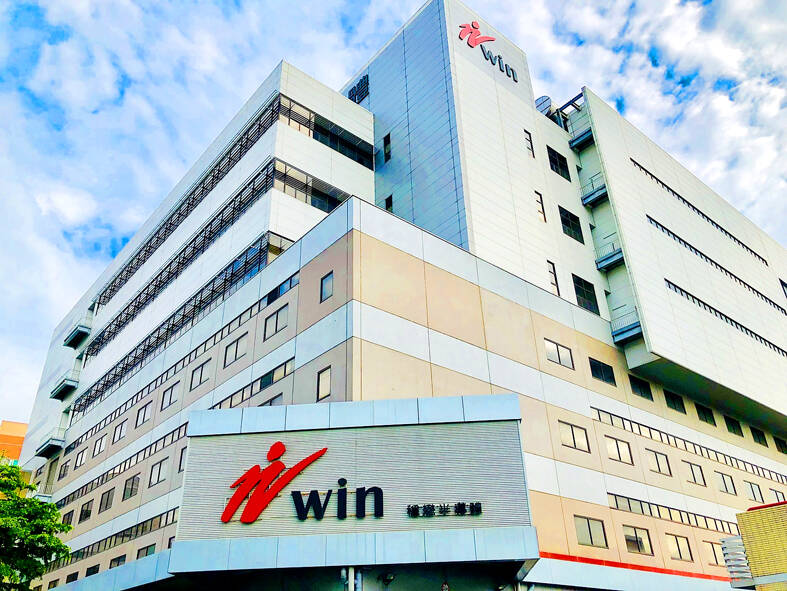Win Semiconductors Corp (穩懋半導體), the world’s largest pure-play gallium arsenide (GaAs) foundry, yesterday said that quarterly losses narrowed to NT$276 million (US$8.78 million), thanks to improving demand from Chinese smartphone makers for new product launches.
That was a significant improvement from losses of NT$479 million in the first quarter, the company said.
Capacity utilization climbed to 40 percent last quarter from 20 percent in the previous quarter, it said, adding that it expects equipment loading to rise further this quarter.

Photo: Screen grab from company Web site
“We started to see nascent signs of an improvement in the smartphone market in the second quarter. We also received more rush orders from Chinese smartphone customers,” Win Semiconductors president Steven Chen (陳舜平) said at an online investors’ conference.
“However, we cannot be certain if that means the year-long inventory correction is coming to an end,” he said.
The company expects revenue to increase by a low-single-digit percentage this quarter from NT$3.94 billion last quarter, as demand for power amplifiers used in smartphones picks up ahead of the introduction of new premium phones.
Gross margin is to drop to about 12 to 16 percent this quarter compared with 20.1 percent last quarter, the company said.
Last quarter’s gross margin outpaced the company’s forecast of a mid-teens percentage, thanks to asset gains, the company said.
An unfavorable product mix is one of the major factors that would lead to lower margins this quarter, Chen said.
Only one segment, power amplifiers used in smartphones, would see an increase in demand, Chen said, as demand for infrastructure, Wi-Fi and optical segments is affected by macroeconomic headwinds.
Power amplifiers made up between 30 and 35 percent last quarter, the biggest revenue contributor to the company, it said.
That was an increase from between 25 and 30 percent in the first quarter.
Infrastructure came next, making up between 25 and 30 percent last quarter.
Wi-Fi made up 15 to 20 percent of the company’s revenue.
Commenting on the company’s new technology advancement, Win Semiconductors said that some customers have adopted Wi-Fi 6E products.
As smartphone vendors and chipmakers have started developing next-generation Wi-Fi 7 products, Win Semiconductors expects that to help boost the company’s revenue due to higher consumption of GaAs.
Asked about growing competition from Chinese peers, Chen said that the company focuses on providing mid-to-high-end GaAs to its Chinese customers, a different segment from the low-end GaAs made by most Chinese manufacturers.
Win Semiconductors has allocated NT$4 billion for capital expenditure this year, slightly lower than last year’s spending.
The company plans to use most of the funds for new facilities and manufacturing equipment at its new plant in the Southern Taiwan Science Park (南部科學園區), it said.

SEEKING CLARITY: Washington should not adopt measures that create uncertainties for ‘existing semiconductor investments,’ TSMC said referring to its US$165 billion in the US Taiwan Semiconductor Manufacturing Co (TSMC, 台積電) told the US that any future tariffs on Taiwanese semiconductors could reduce demand for chips and derail its pledge to increase its investment in Arizona. “New import restrictions could jeopardize current US leadership in the competitive technology industry and create uncertainties for many committed semiconductor capital projects in the US, including TSMC Arizona’s significant investment plan in Phoenix,” the chipmaker wrote in a letter to the US Department of Commerce. TSMC issued the warning in response to a solicitation for comments by the department on a possible tariff on semiconductor imports by US President Donald Trump’s

The government has launched a three-pronged strategy to attract local and international talent, aiming to position Taiwan as a new global hub following Nvidia Corp’s announcement that it has chosen Taipei as the site of its Taiwan headquarters. Nvidia cofounder and CEO Jensen Huang (黃仁勳) on Monday last week announced during his keynote speech at the Computex trade show in Taipei that the Nvidia Constellation, the company’s planned Taiwan headquarters, would be located in the Beitou-Shilin Technology Park (北投士林科技園區) in Taipei. Huang’s decision to establish a base in Taiwan is “primarily due to Taiwan’s talent pool and its strength in the semiconductor

Industrial production expanded 22.31 percent annually last month to 107.51, as increases in demand for high-performance computing (HPC) and artificial intelligence (AI) applications drove demand for locally-made chips and components. The manufacturing production index climbed 23.68 percent year-on-year to 108.37, marking the 14th consecutive month of increase, the Ministry of Economic Affairs said. In the first four months of this year, industrial and manufacturing production indices expanded 14.31 percent and 15.22 percent year-on-year, ministry data showed. The growth momentum is to extend into this month, with the manufacturing production index expected to rise between 11 percent and 15.1 percent annually, Department of Statistics

An earnings report from semiconductor giant and artificial intelligence (AI) bellwether Nvidia Corp takes center stage for Wall Street this week, as stocks hit a speed bump of worries over US federal deficits driving up Treasury yields. US equities pulled back last week after a torrid rally, as investors turned their attention to tax and spending legislation poised to swell the US government’s US$36 trillion in debt. Long-dated US Treasury yields rose amid the fiscal worries, with the 30-year yield topping 5 percent and hitting its highest level since late 2023. Stocks were dealt another blow on Friday when US President Donald